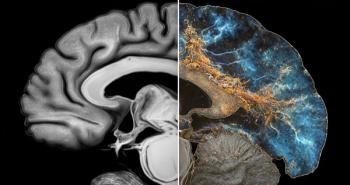
Cardiac Imaging: Hybrid Technologies
MONTREAL -- Devices that fuse CT angiography (CTA) with perfusion imaging would provide a more complete clinical picture than either modality alone, said an investigator here.
MONTREAL, Sept. 13 -- Hybrid technologies that fuse perfusion imaging with CT angiography (CTA) would provide a fuller clinical picture that can guide decision making better than one modality alone, according to an investigator here.
At a symposium sponsored by Philips, held in conjunction with the American Society of Nuclear Cardiology meeting, John J. Mahmarian, M.D., of the Methodist DeBakey Heart Center in Houston described the benefits of CTA fused with single photon emission computed tomography (SPECT) perfusion scanning.
According to Dr. Mahmarian, CTA is a novel but strong test for evaluating the presence and extent of coronary artery disease and severity of luminal stenosis. It can also reliably determine the patency of stented and grafted coronary arteries, identify coronary artery anomalies, and differentiate ischemic from non-ischemic cardiomyopathy.
In the emergency room, it can be used to determine whether chest pain is associated with acute coronary syndrome. CTA is, "very good at not only excluding coronary disease but also determining the severity of disease in the coronary tree," he said. "It also appears that CTA is very good at differentiating calcified and noncalcified plaque, and that may have individual prognostic implications."
SPECT, on the other hand, is a time-honored method of perfusion imaging for cardiologists. "We can't forget that the functional/biological information is still very important," said Dr. Mahmarian. A normal SPECT result is associated with a low risk of cardiac events, while significant ischemia, as seen on SPECT, is associated with a high risk of events.
The complementary roles of CTA and SPECT indicate that fusing the two modalities would be of clinical benefit. "By using these techniques together," said Dr. Mahmarian, "we may better detect and clarify the presence of coronary artery disease, we may improve risk stratification, and we may better localize in which particular artery ischemia may be present and therefore better guide interventional techniques."
Following an abnormal perfusion scan, CT/SPECT can be used to identify the culprit artery and help appropriately target percutaneous coronary intervention. It serves as a road map to identify "hot spots" of unstable plaque. One machine that performs both CT and SPECT eliminates the need for serial testing, which occurs all too frequently.
Dr. Mahmarian gave several examples of patients who required serial tests with CTA and SPECT and would therefore have benefited from hybrid technology. In one case, a 75-year-old women with multiple risk factors and chest pain underwent SPECT, which had an equivocal result. Calcium scoring showed calcification in two arteries, and CTA revealed plaque without stenosis.
In another case, a 90-year-old woman with chest pain had a normal SPECT perfusion test, but her chest pain continued. Eventually, she underwent CTA, which revealed plaque in two arteries but no occlusions.
A 30-year old Hispanic man with hypertensive crisis and chest pain had a normal SPECT except for some post-stress stunning. CTA revealed calcification in two arteries but no significant obstructive disease.
A 48-year-old man with hypertension, hypercholesterolemia, borderline diabetes, but no history of coronary artery disease presented with chest pain. SPECT perfusion was equivocal, but CTA revealed extensive soft plaque and a very high grade lesion that required catheterization and stenting.
"The whole idea of fusion is to fuse the myocardial perfusion images to the CT arterial tree and therefore look at vascular arterial territories and see which areas may serve as scarred myocardium and which areas may serve as ischemic myocardium to better tailor what we do in the cath lab," said Dr. Mahmarian.
His fifth case served as an example. In this case, a 61-year-old male with hypertension and hypercholesterolemia was referred for exertional chest pain. SPECT revealed several ischemic abnormalities, and CTA revealed several high-grade lesions and extensive calcified and non-calcified plaque. Fusion of the SPECT and CTA images allowed for visualization of the entire arterial tree, which helped guide revascularization.
Philips has recently developed version 7.0 of their autoQUANT software, which can be used to combine CT and perfusion data, even when the data are collected from different machines. Piotr Slomka, Ph.D., of Cedars-Sinai Medical Center at the University of California at Los Angeles described some of its new features at the symposium. This software helps eliminate artifacts caused by alignment problems, which is an issue whether scans are performed on different machines or the same machine.
E. Kent Yucel, M.D., of the Boston VA Healthcare System in West Roxbury, Mass., is also excited about hybrid technologies that fuse CT with either positron emission tomography (PET) or SPECT perfusion imaging. Like Dr. Mahmarian, he sees CT and perfusion scans as complementary modalities that together offer a complete picture.
Dr. Yucel, who is chair of the American College of Radiology (ACR) Panel on Cardiovascular Imaging but who was not a participant in this symposium, considers fusion of perfusion and CT images taken from different machines to be a bit of a "gimmick" because any experienced clinician should be able to look at the images separately and fuse them in their minds. Machines that fuse CT with PET or SPECT are definitely beneficial, however, because they save time by providing the greatest amount of information with one test he said.
While he is eager to acquire a CT/PET scanner, Dr. Yucel believes that CT/SPECT is not yet a mature technology, and he is holding off until it is further along in development. Because cardiac imaging has traditionally been performed with SPECT, and SPECT is less expensive than PET, he believes that CT/SPECT imaging will probably be the hybrid technology that appeals to cardiologists.
In 10 years, he predicts, almost everyone will have switched from performing CT and perfusion separately to using a hybrid machine. The ultimate cost savings of using hybrid machines will derive from fewer patients requiring serial testing with SPECT and CT and fewer patients undergoing needless catheterization because of false positive rates associated with perfusion imaging when used alone.
Newsletter
Enhance your clinical practice with the Patient Care newsletter, offering the latest evidence-based guidelines, diagnostic insights, and treatment strategies for primary care physicians.




























































































































































































































































































